Title of paper under discussion
Increased Gray Matter Volume of Left Pars Opercularis in Male Orchestral Musicians Correlate Positively With Years of Musical Performance
Authors
Ihssan A. Abdul-Kareem, Andrej Stancak, Laura M. Parkes and Vanessa Sluming
Journal
JOURNAL OF MAGNETIC RESONANCE IMAGING 33:24–32 (2011)
Link to paper (free access)
Overview
Broca’s area, a region in the left hemisphere of the brain critically involved in speech, is made up of two parts: the pars opercularis (POP) and the pars triangularis (PTR). A group of musicians and non-musicians underwent MRI scans to measure the size of these parts in each of their brains. It turned out that the musicians each had a considerably larger pars opercularis in their left hemisphere than the non-musicians, and the longer they had been performing the larger it was. This finding ties in with the hypothesis that the left pars opercularis is in a mirror neuron network, critically involved in the kind of hearing-action integration that is central to musical performance.
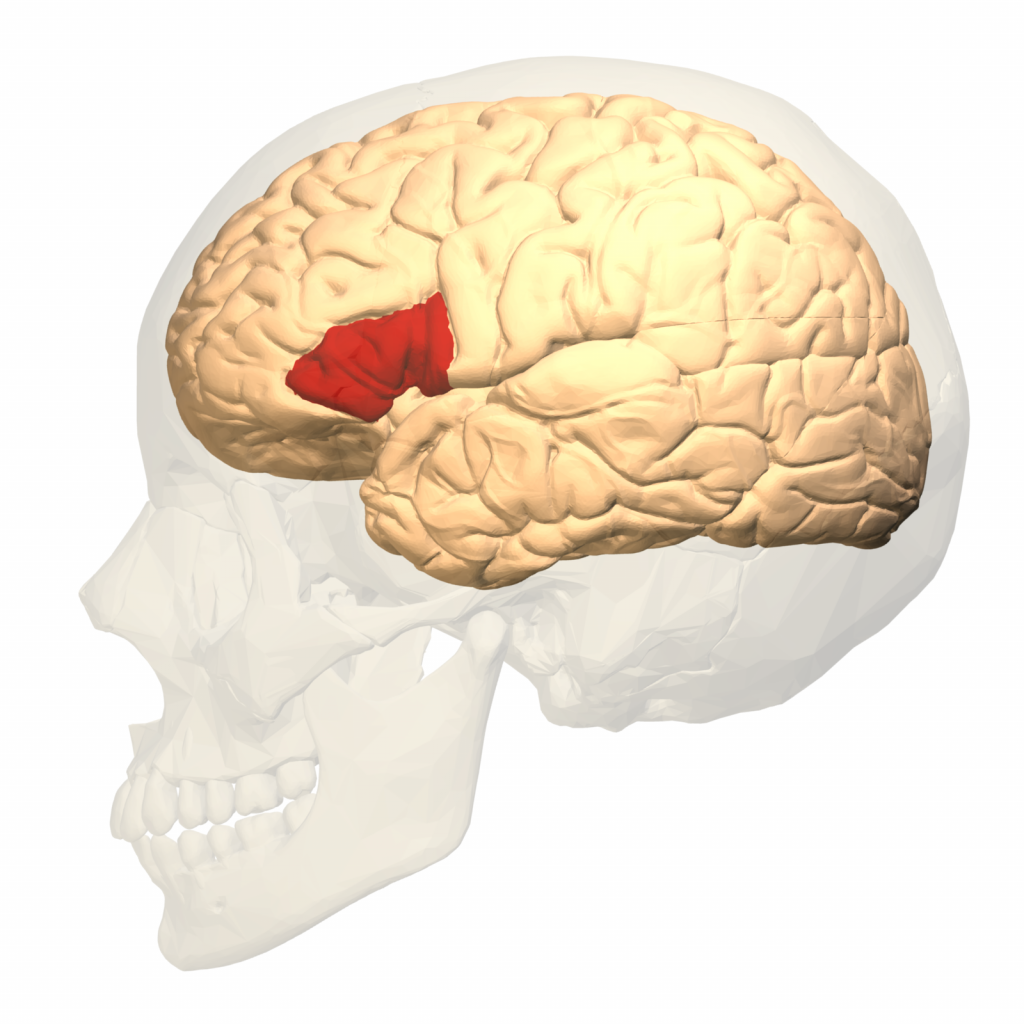
Introduction – Broca’s area and its constituent parts
Scientists have long suspected that Broca’s area plays a role in processing music as well as speech, with studies linking it to musical discrimination, audio spatial localisation, musical syntax, musical memory, musical improvisation, sight reading and score reading. The authors of this paper had already found that Broca’s area was enlarged in musicians, and wanted to investigate further – was it the pars opercularis and/or the pars triangularis that was/were enlarged?
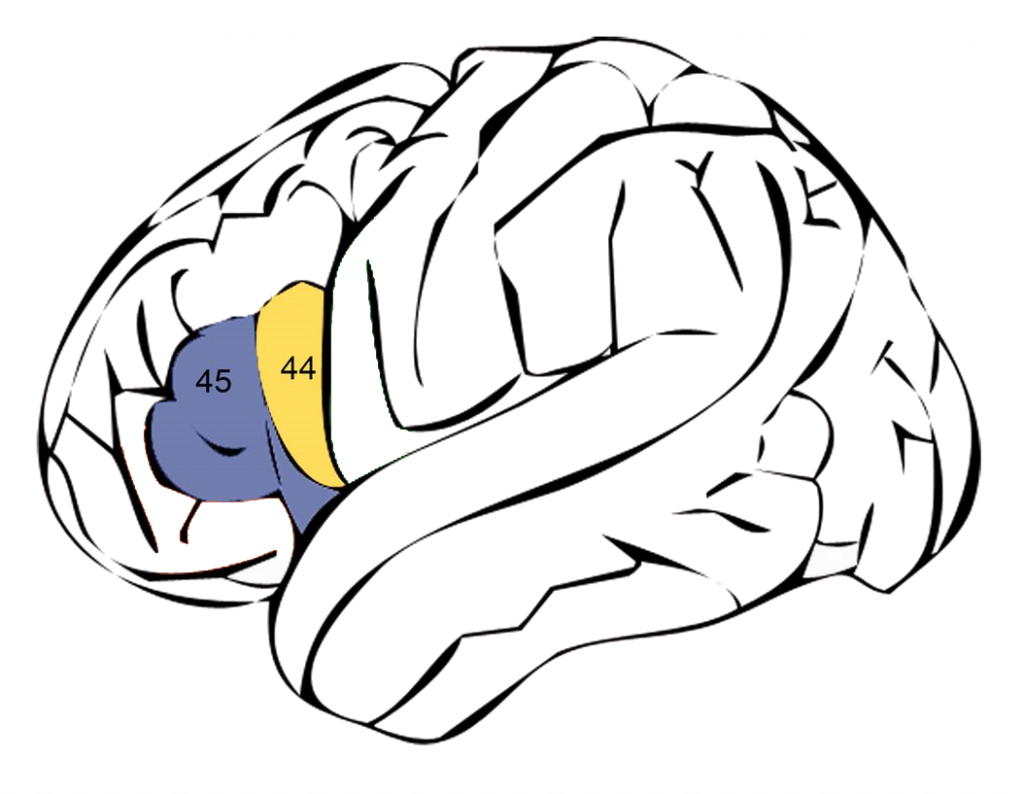
These two parts, also called Brodmann’s area 44 (pars opercularis) and Brodmann’s area 45 (pars triangularis) are neighbours but have different cell architecture under the microscope, and connect to different regions of the brain. Speech-wise they are thought to play slightly different roles: the pars opercularis is involved in “syntactic processing and phonologically based word memory”, whereas the pars triangularis is involved in “semantic processing, rhyming ability, phonological awareness and lexical decision making”.
Alongside its role in speech and music, Broca’s area is also thought to be involved more generally in motor processing, with the pars opercularis perhaps a key component of the human ‘mirror neuron’ system (though the existence of mirror neurons in humans remains controversial). Mirror neurons, first described in monkeys, are nerve cells that fire not only when an animal acts but also when a animal observes that action. The pars opercularis is thought to be part of the mirror neuron system in humans because it is activated during action observation and imitation; the pars triangularis, in contrast, is activated during action observation but not imitation.
Method
For this experiment scientists from Liverpool University in the UK recruited 26 right-handed native English-speaking male musicians from a major British orchestra, together with 26 right-handed male non-musicians (controls) – according to the authors “insufficient [numbers of] right-handed female musicians volunteered to warrant the inclusion of women in this study.” Each musician was asked to reveal how many years’ experience they had on their instrument.
Their brains were MRI-scanned and the resulting images were assessed by trained neuroanatomists. The specific parts of the brain under investigation – the pars opercularis (POP) and the pars triangularis (PTR) – are definable anatomically by the “sulcal contours” (the grooves on the brain’s surface) that make up their edges (boundaries). By identifying these parts’ boundaries in each brain the neuroanatomists were able to calculate the volume of each part; and because each part comprises white matter (WM) and grey matter (GM) they went further and calculated the volume of WM and GM within each part. So for each brain (left and right hemispheres) the neuroanatomists provided 8 volume measurements: left POP WM, left POP GM, left PTR WM, left PTR GM, right POP WM, right POP GM, right PTR WM and right PTR GM.
Statistical analysis was then carried out on the resulting figures to look for any correlations between musicianship, including number of years studied, and the various volume measurements.
Results
It turned out that male orchestral musicians have “significantly larger GM [grey matter] volume of left POP [pars opercularis]…compared to non-musicians” and that none of the other seven species of volume measurement was correlated with musicianship:
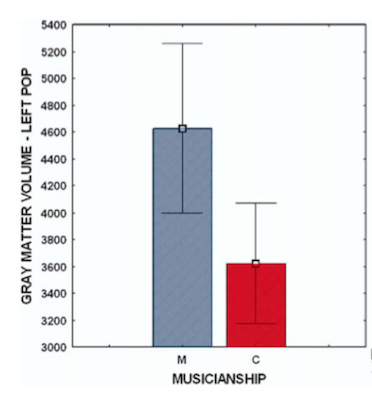
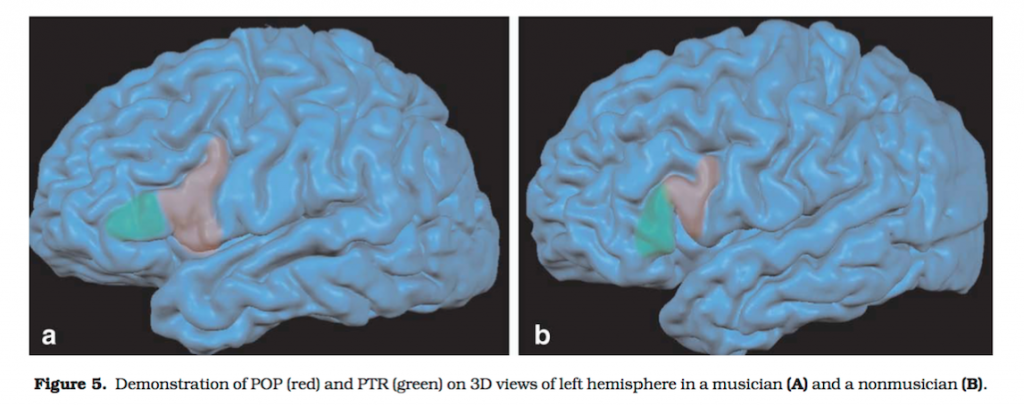
Furthermore in the musicians group there was a positive correlation between GM volume of left POP and years of musical performance:
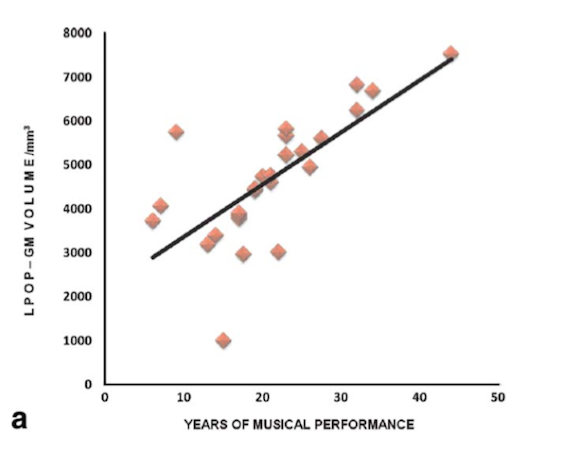
This positive correlation was especially striking when compared with a similar graph for non-musicians, whose left POP GM volume seems (though not statistically significantly) to decrease with age:
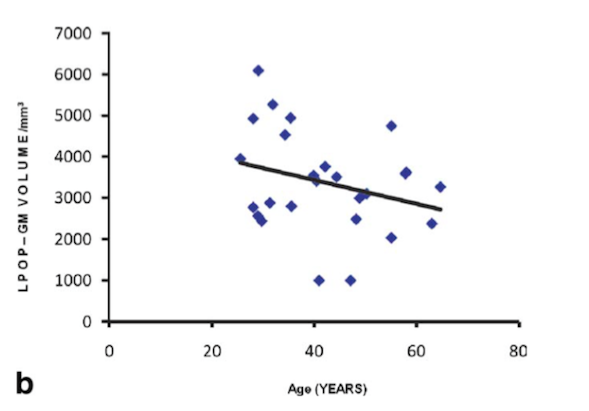
Discussion
These scans demonstrate structural neuroplasticity whereby a brain can “adapt to environmental pressures and influences”, the adaptation here being an enlargement of the left pars opercularis in response to musical influences. This adds ‘left POP’ to the long list of brain areas previously shown to undergo neuroplastic changes in response to musical training.
As outlined in the introduction, Broca’s area has long been suspected of being involved in music and movement as well as speech: for instance, “children with dyslexia exhibit specific timing difficulties in the domain of music, motor control and language” and giving them “music lessons…can lead to improvements in language skills”. In addition “it has also been found that patients with severe nonfluent aphasia can benefit from Melodic Intonation Therapy, a highly imitative speech therapy based on singing.”
As well as the role of pars opercularis in musical activities (e.g. processing musical syntax, calculating harmonic relations and detecting music-structural irregularities) the authors are keen to highlight “a new functional role for POP which is action understanding and imitation”. They remind us that POP is considered a hub “of the human mirror neuron network….activated [both] by the execution of manual action and by the observation of the same action performed by others”. Such “action-listening coupling” has been specifically demonstrated in the left POP whilst listening to action-related sentences and, in another experiment, whilst listening to previously practised music. This particular common coding, whereby listening and action share a common mental representation, only occurs in the left hemisphere, and this “left lateralization of the human mirror neuron system in the auditory domain has been suggested to facilitate the emergence of language” according to the authors.
Why should such a mirror neuron system benefit an orchestral musician? Abdul-Kareem and his colleagues suggest that “such neural equivalence between the sender and receiver of a message is felt to be a prerequisite of communication, learning and skill acquisition, and therefore essential for orchestral performance by ensemble musicians. We could therefore speculate that musicians with the greatest left POP volumes could survive the hard and competitive environment of the orchestra better than musicians with smaller left POP volume.”
Coda
Royal Liverpool Philharmonic Orchestra, cond. Vasily Petrenko
Hi Adrian,
POP was my nickname in “Gavin” days! Perhaps it was a compliment after all. (I think actually it was a reference to my persistent asking or “popping the” questions. It is nice to know that my pars opercularis was busy detecting music-structural irregularities.
Is their a region that deals in following rules and general trouble with authority? Lockdown would be a good time to test for it!!! (Zero cases in Chiswick at all last week) XBen
Hi Pop, thanks for comment – authority now reasserting itself as we speak, hope all well; your family’s praises were being sung in the most glowing terms by Ben(edict) the other day, lockdown doesn’t seem to have taken a toll 🙂